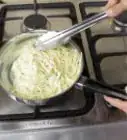This article was co-authored by wikiHow Staff. Our trained team of editors and researchers validate articles for accuracy and comprehensiveness. wikiHow's Content Management Team carefully monitors the work from our editorial staff to ensure that each article is backed by trusted research and meets our high quality standards.
The wikiHow Culinary Team also followed the article's instructions and verified that they work.
This article has been viewed 20,289 times.
Learn more...
Homemade ravioli have a fresh, delicious taste that can't be beat. Unfortunately, making pasta dough from scratch can be a long, complicated process that you may not have time for when you're preparing a week night dinner. That doesn't mean you can't enjoy homemade ravioli, though -- using prepared wonton wrappers to stand in for homemade pasta dough means you can whip up raviolis whenever you want. A simple cheese ravioli will satisfy most diners, but you can customize the filling to suit your tastes.
Ingredients
- 24 ounces (680 g) whole milk ricotta
- 3 cups (300 g) freshly grated parmesan cheese
- 2 eggs
- Salt and pepper, to taste
- 1 egg
- 1 teaspoon (5 ml) water
- 50 wonton wrappers
Steps
Preparing the Filling and Egg Wash
-
1Combine the ricotta and parmesan cheese. Add 24 ounces (680 g) of whole milk ricotta and 3 cups (300 g) of freshly grated parmesan cheese to a large bowl. Mix them together until they are fully combined.[1]
- A simple cheese filling is the most common option for raviolis. However, you can use whatever filling you like for your wonton wrapper raviolis.
- You can add herbs and spices to the cheese filling, such as basil, thyme, sage, or nutmeg.
- Meats, such as sausage, chicken, prosciutto, and pancetta, can make tasty ravioli fillings. You may also opt for a seafood filling, such as crab or lobster.
- Vegetables and greens, such as mushrooms, butternut squash, pumpkin, spinach, and broccoli rabe, work well as ravioli fillings too.
- You can substitute other cheeses, such as mascarpone or gorgonzola, for the ravioli filling.
-
2Mix in the eggs. After you’ve mixed the cheeses together, add 2 eggs to the bowl. Stir the eggs into the cheese until they are fully incorporated.[2]
- You can use egg substitute in place of the eggs if you prefer.
Advertisement -
3Season the mixture with salt and pepper. Once the eggs are mixed into the cheese filling, add some salt and pepper to taste to the bowl. Mix well to ensure that the filling is properly seasoned.[3]
- You can add other seasonings to the filling if you like. Crushed red pepper or Italian seasoning are some options to consider.
-
4Beat another egg with some water. To make the egg wash to seal the wonton wrapper raviolis, add 1 egg to a small bowl. Mix in 1 teaspoon (5 ml) of water and beat the mixture together until it is fully combined. Set aside for the moment.[4]
Assembling the Ravioli
-
1Lay out some wonton wrappers and brush them with the egg wash. To begin making the ravioli, set out 8 to 10 wonton wrappers on the counter or cutting board in front of you. Dip a pastry brush in the egg wash you prepared, and brush it along all the edges of the wrappers.[5]
- It’s best to work with only a small number of the wrappers at time. If you set out half of the wrappers at once, they may dry out by the time you are finished assembling them.
-
2Add some of the filling to the center of the wrappers. After you’ve applied the egg wash to the edges, place approximately 1 tablespoon (15 g) of the filling in the center of each wrapper. Make sure to keep the filling away from the edges of the wrapper, so it doesn’t leak out during cooking.[6]
- Don’t overfill the ravioli. They may burst during cooking, so the filling seeps out.
-
3Place wonton wrappers on top of the first and seal the edges. When the filling is in place in the center of the wrappers, set another wonton wrapper on top of all the others that you’ve laid out. Use a finger to press down along the edges and seal the ravioli with the egg wash.[7]
- After you’ve pressed the edges of the wrappers together, lift the raviolis from the counter and pinch them together again to ensure that they’re sealed.
- For a more decorative look, you can use a fork to crimp along the edges of the ravioli.
- You can leave the ravioli as they are in their square shape, or use a medium cookie cutter in a fun shape, such as a heart or star, to cut them out.
- If you prefer, you can use 1 wonton wrapper for each ravioli instead of pressing two together. Place the filling in the center, and fold one corner to the other to form a triangle shape to seal.
-
4Transfer the ravioli to a baking sheet and repeat the process. When the ravioli are sealed, place them face down on a baking sheet that’s lined with parchment paper. Repeat the assembling process with the remaining wonton wrappers.[8]
- Be sure to lay a piece of parchment paper or plastic wrap between the ravioli if you have multiple layers of them. That will keep them from sticking together.
- If you don’t plan to cook the ravioli right away, you can wrap the entire baking sheet with plastic wrap and refrigerate them for up to 2 days.
Cooking the Ravioli
-
1Bring a pot of water to a boil. To cook the ravioli, fill a large pot approximately ⅔’s full with water. Place the pot on the stove, and heat on high until the water comes to a full boil.[9]
- Add a pinch or two of salt to the water before you bring it to a boil. That will help season the ravioli as they cook.
-
2Lower the heat and add the ravioli. After the water has come to a boil, lower the heat to medium to bring it to a simmer. Stir the water to create a whirlpool effect, and carefully drop 10 to 12 raviolis one by one into the pot.[10]
-
3Poach the ravioli for a few minutes. Once the raviolis are in the water, allow them to cook for 2 to 3 minutes. You’ll know that they’re done when they puff slightly and float to the top of the pot.[11]
- If you’ve added a raw poultry or fish filling to the ravioli, make sure that the center is opaque to verify that they’re done cooking.
-
4Remove the ravioli from the water to drain. When the ravioli are finished cooking, use a slotted spoon to lift them out of the water. Place them in a colander and shake well to ensure that they’re fully drained. Set them aside for the moment, and repeat the process with the remaining ravioli.[12]
-
5Top the ravioli with sauce and serve. When you’re finished cooking all of the ravioli, divide them between several dishes. Add your favorite sauce to the top of the ravioli and serve.[13]
- A basic tomato or marinara sauce works well with cheese ravioli, but any sauce, such as alfredo, arrabiata, vodka, or bolognese, will work well.
Things You’ll Need
- Large bowl
- Wooden spoon
- Small bowl
- Whisk
- Pastry brush
- Small spoon
- Baking sheet
- Parchment paper
- Large pot
- Slotted spoon
- Colander
References
- ↑ http://thepioneerwoman.com/cooking/ravioli-three-ways/
- ↑ http://thepioneerwoman.com/cooking/ravioli-three-ways/
- ↑ http://thepioneerwoman.com/cooking/ravioli-three-ways/
- ↑ hepioneerwoman.com/cooking/ravioli-three-ways/
- ↑ http://www.foodnetwork.com/recipes/wonton-skin-raviolis-recipe
- ↑ http://www.foodnetwork.com/recipes/wonton-skin-raviolis-recipe
- ↑ http://www.foodnetwork.com/recipes/wonton-skin-raviolis-recipe
- ↑ http://www.foodnetwork.com/recipes/wonton-skin-raviolis-recipe
- ↑ http://www.foodandwine.com/recipes/easy-wonton-spinach-and-feta-ravioli















































